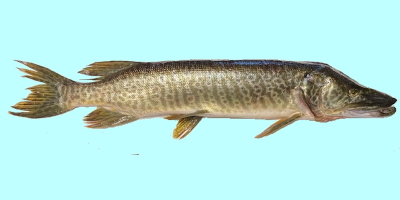|
|
Tiger Muskie fish, its habitats, characteristics, fishing methods.
The Tiger Muskie is the very smart fish that is not that easy to find, difficult to catch and land. It fights hard with it razor sharp teeth and many sharp bones around their mouth and jaws. A combination of understanding the fish and the techniques used to catch them will help you to hook more fish to the end of your line. Better knowing and understanding of the fish that you are trying to catch will make you a more successful angler, whether you are fishing for trout on a river or surfing on the beach or trolling on the open water.

|
The Tiger Muskie is the hybrid of the
Northern Pike and
Muskie. It is usually infertile and has characteristics of both parents. The hybrid has distinct tiger bars on a light background, similar to the barred coloration pattern of; some muskie. Its fins and tail lobes are rounded like a Northern Pike's but colored like a Muskie's. The cheek scale and mandible-pore patterns are intermediate between a Northern Pike's and Muskie's.
|
Description
The exception to this is the tiger musky, which is a distinctive body that is long and sleek with a single dorsal fin located very far back near the tail. The pelvic (ventral) fins are located relatively far back on the belly, about half way between the pectoral fins and the tail, instead of directly under the pectoral fins. The mouth is large with the maxillae reaching back at least to the middle of the eyes, and broad, like a ducks bill, but full of teeth.
The tiger muskie grows slightly faster than either pure-strain parent in the first several years of life. It can exceed 30 pounds. Some tiger muskie occurs naturally, though most hybrids are produced in hatcheries. They are useful in stocking because they grow quickly and endure high temperatures better than either paren does. Hybrids are easier to rise in a hatchery than pure-strain muskie, they reach legal size sooner and they are easier to catch.
Habitats
The Muskie prefer clear waters where they hide between weed edges, rocks or other structures to rest before praying. In waters where Muskie grows without
Northern Pike present, the muskie chooses the same weedy, flooded wetlands that serve as Northern Pike spawning areas elsewhere. If Pike are introduced to these lakes, the Northern Pike spawn in these same areas but about 2 weeks earlier. So when the muskie fry hatch, they may be eaten by the larger young Northern Pike. Young Muskie usually hangs just below the surface of the water, where they are easy prey for birds from above or fish from below. Where the two species have coexisted for thousands of years, the Muskie seems to have adopted different spawning areas. Northern pike use the weedy shorelines of bays and presumably have less chance to prey on the muskie.
Tiger Muskies eats anything it can find. It is looking for the easiest available food and locates itself in the highest possible location to obtain easy meals. The fish is spookier than Muskie, not as dumb as Pike, and is very well fed with the natural sources of food. This makes it a very difficult trophy to find, catch and land.
Spawning
Because Tiger Muskie is usually sterile hybrids and do not reproduce, their numbers can be controlled by changing the stocking rate.
Fishing Methods.
Effective methods for catching this hard fighting fish include bait casting and trolling. Trolling fishing speed for Muskie is 4-6 miles per hour, maximum is 10 miles per hour. You will catch Muskie trolling really fast and generally the really big Muskie hit the faster baits but trolling at a slower speed enables you to catch Muskie of all sizes. Muskie will hit any size lure: little jigs, small, medium or big one. The size of the lure is based on the amount of weeds in the fishing area. In open water, you can troll with bigger lures as the water is cleaner with fewer weeds. In water that is weedier or if you are trolling along side thick weeds, a smaller lure is best. Various kinds of crank-baits work well if you casting into patches of heavily vegetated waters or between lines of thick weeds. The Muskie likes when the pressure and weather stay consistent, with no changes either it is nice or miserable on a lake.
Either you troll or cast, better to use heavy duty or medium-heavy graphite bait-casting rod, from 5 to 7 feet in length. Graphite material is preferred because it is lighter in weight, which causes less hand fatigue, and it is more sensitive and flexible. Monofilament line or braided line of 20 to 40 pound-test any color. The line must be fitted with a solid steel leader because both Tiger Muskie and muskie have razor sharp teeth and many sharp bones around their mouth and jaws that can easily cut the line while fighting.
|
|
|

